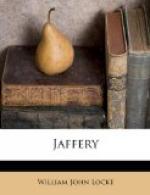I was very anxious to see what impression the book would make upon her. Although I had reassured Jaffery, I could, scarcely conceive the possibility of the book being taken as the work of Adrian.
“Of course I would,” said Jaffery eagerly. “But that’s just it. You weren’t equal to the worry. Now you’re all right and I agree with Hilary. You ought to read it. You see, some of the bridges are so jolly clumsy.”
Doria turned to my wife. “Do you think I would be justified?”
“Decidedly,” said Barbara. “You ought to read it at once.”
So it came to pass that, after lunch, Doria came into my study and demanded the set of proofs. She took them up to her bedroom, where she remained all the afternoon. I was greatly relieved. It was right that she should know what was going to be published under Adrian’s name.
In Jaffery’s presence, I disclosed to Barbara the identity of the author. He said to her much the same as he had said to me before lunch, with, perhaps, a little more shamefacedness. Were it not for reiteration upon reiteration of the same things in talk, life would be a stark silence broken only by staccato announcement of facts. At last Barbara’s eyes grew uncomfortably moist. Impulsively she flew to Jaffery and put her arms round his vast shoulders—he was sitting, otherwise she could not have done it—and hugged him.
“You’re a blessed, blessed dear,” she said; and ashamed of this exhibition of sentiment she bolted from the room.
Jaffery, looking very shy and uncomfortable, suggested a game of billiards.
To Barbara and myself awaiting our guests in the drawing-room before dinner, the first to come was Doria, whom we hadn’t seen since lunch; an arresting figure in her low evening dress; you can imagine a Tanagra figure in black and white ivory. Her face, however, was a passion of excitement.
“It’s wonderful,” she cried. “More than wonderful. Even I didn’t know till to-day what a great genius Adrian was. All these things he describes—he never saw them. He imagined, created. Oh, my God! If only he had lived to finish it.” She put her two hands before her eyes and dashed them swiftly away—“Jaffery has done his best, poor fellow. But oh! the bridges he speaks of—they’re so crude, so crude! I can see every one. The murder—you remember?”
It occurred in the first part of the novel. I had read it. Three or four splashes of blood on the page instead of ink and the thing was done. Admirable. The instinctive high light of the artist.
“I thought it one of the best things in the book,” said I.
“Oh!” she waved a gesture of disgust. “How can you say so? It’s horrible. It isn’t Adrian. I can see the point where he left it to the imagination. Jaffery, with no imagination, has come in and spoiled it. And then the scene on the Barbary Coast of San Francisco, where Fenton finds Ellina Ray, the broken-down star of London musical comedy. Adrian never wrote it. It’s the sort of claptrap he hated. He has often told me so. Jaffery thought it was necessary to explain Ellina in the next chapter, and so in his dull way, he stuck it in.”




